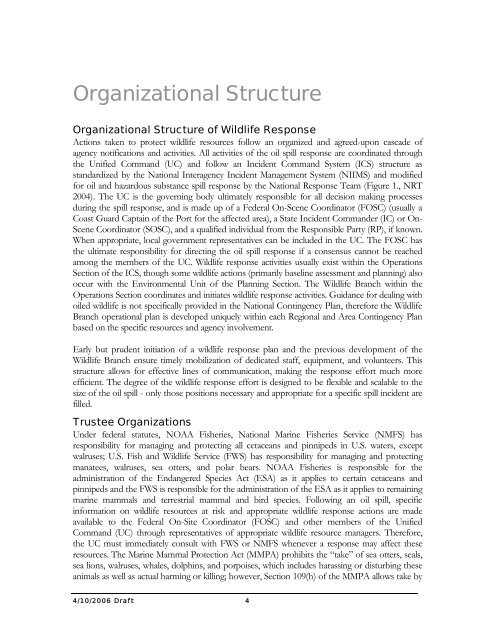Volume III, Appendices EM - National Marine Fisheries Service ...
Volume III, Appendices EM - National Marine Fisheries Service ...
Volume III, Appendices EM - National Marine Fisheries Service ...
Create successful ePaper yourself
Turn your PDF publications into a flip-book with our unique Google optimized e-Paper software.
Organizational Structure<br />
Organizational Structure of Wildlife Response<br />
Actions taken to protect wildlife resources follow an organized and agreed-upon cascade of<br />
agency notifications and activities. All activities of the oil spill response are coordinated through<br />
the Unified Command (UC) and follow an Incident Command System (ICS) structure as<br />
standardized by the <strong>National</strong> Interagency Incident Management System (NIIMS) and modified<br />
for oil and hazardous substance spill response by the <strong>National</strong> Response Team (Figure 1., NRT<br />
2004). The UC is the governing body ultimately responsible for all decision making processes<br />
during the spill response, and is made up of a Federal On-Scene Coordinator (FOSC) (usually a<br />
Coast Guard Captain of the Port for the affected area), a State Incident Commander (IC) or On-<br />
Scene Coordinator (SOSC), and a qualified individual from the Responsible Party (RP), if known.<br />
When appropriate, local government representatives can be included in the UC. The FOSC has<br />
the ultimate responsibility for directing the oil spill response if a consensus cannot be reached<br />
among the members of the UC. Wildlife response activities usually exist within the Operations<br />
Section of the ICS, though some wildlife actions (primarily baseline assessment and planning) also<br />
occur with the Environmental Unit of the Planning Section. The Wildlife Branch within the<br />
Operations Section coordinates and initiates wildlife response activities. Guidance for dealing with<br />
oiled wildlife is not specifically provided in the <strong>National</strong> Contingency Plan, therefore the Wildlife<br />
Branch operational plan is developed uniquely within each Regional and Area Contingency Plan<br />
based on the specific resources and agency involvement.<br />
Early but prudent initiation of a wildlife response plan and the previous development of the<br />
Wildlife Branch ensure timely mobilization of dedicated staff, equipment, and volunteers. This<br />
structure allows for effective lines of communication, making the response effort much more<br />
efficient. The degree of the wildlife response effort is designed to be flexible and scalable to the<br />
size of the oil spill - only those positions necessary and appropriate for a specific spill incident are<br />
filled.<br />
Trustee Organizations<br />
Under federal statutes, NOAA <strong>Fisheries</strong>, <strong>National</strong> <strong>Marine</strong> <strong>Fisheries</strong> <strong>Service</strong> (NMFS) has<br />
responsibility for managing and protecting all cetaceans and pinnipeds in U.S. waters, except<br />
walruses; U.S. Fish and Wildlife <strong>Service</strong> (FWS) has responsibility for managing and protecting<br />
manatees, walruses, sea otters, and polar bears. NOAA <strong>Fisheries</strong> is responsible for the<br />
administration of the Endangered Species Act (ESA) as it applies to certain cetaceans and<br />
pinnipeds and the FWS is responsible for the administration of the ESA as it applies to remaining<br />
marine mammals and terrestrial mammal and bird species. Following an oil spill, specific<br />
information on wildlife resources at risk and appropriate wildlife response actions are made<br />
available to the Federal On-Site Coordinator (FOSC) and other members of the Unified<br />
Command (UC) through representatives of appropriate wildlife resource managers. Therefore,<br />
the UC must immediately consult with FWS or NMFS whenever a response may affect these<br />
resources. The <strong>Marine</strong> Mammal Protection Act (MMPA) prohibits the “take” of sea otters, seals,<br />
sea lions, walruses, whales, dolphins, and porpoises, which includes harassing or disturbing these<br />
animals as well as actual harming or killing; however, Section 109(h) of the MMPA allows take by<br />
4/10/2006 Draf t 4
















